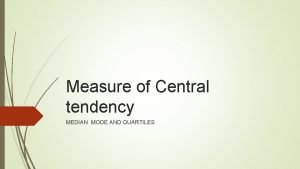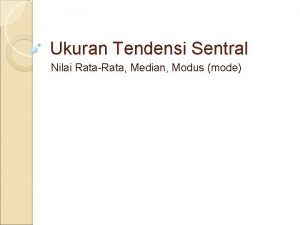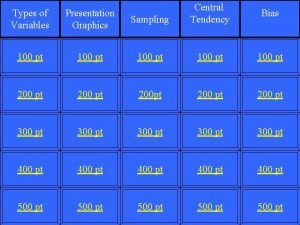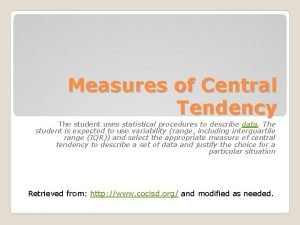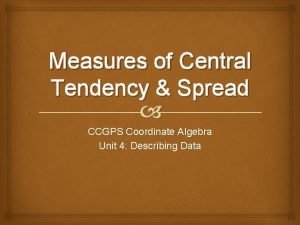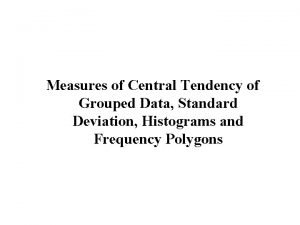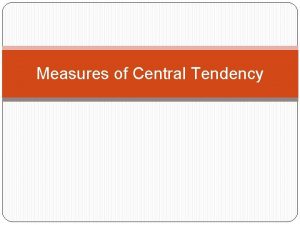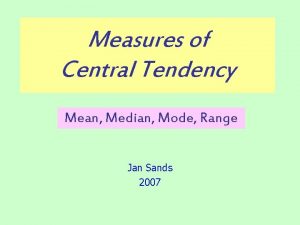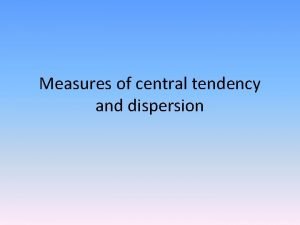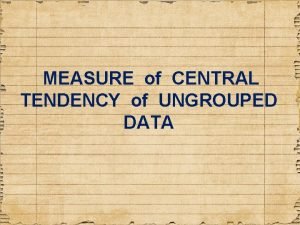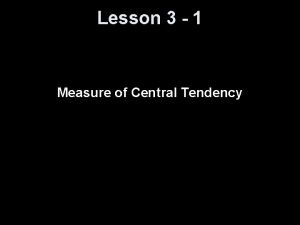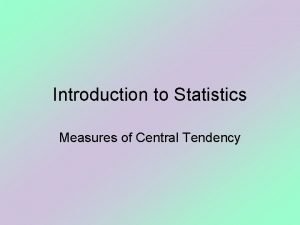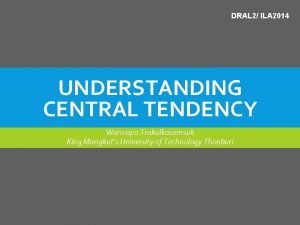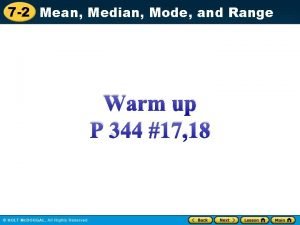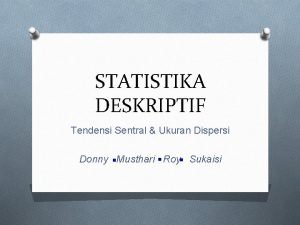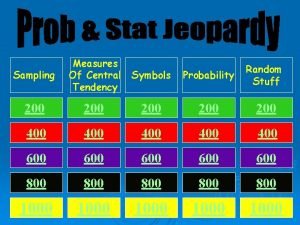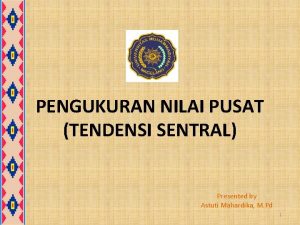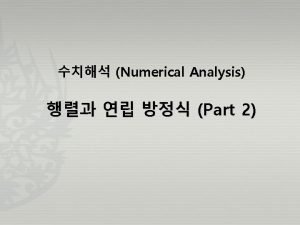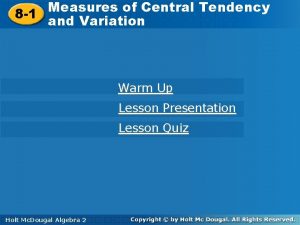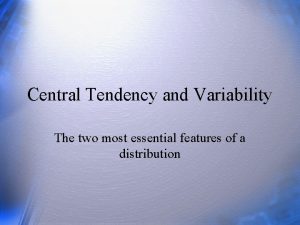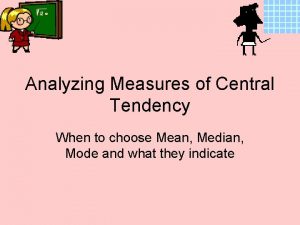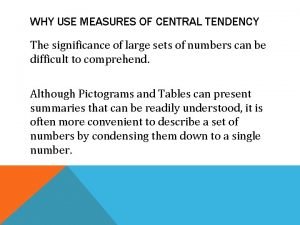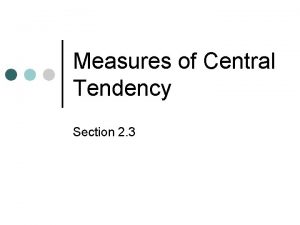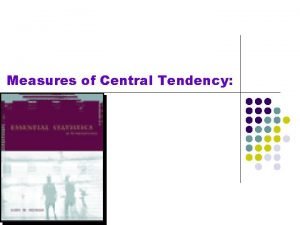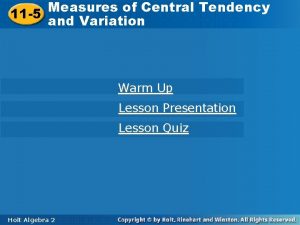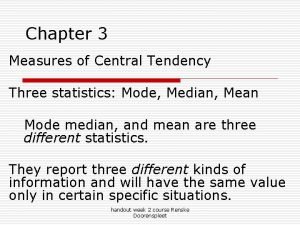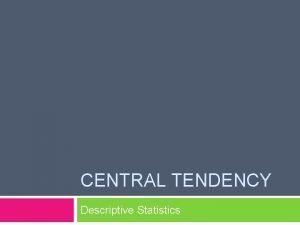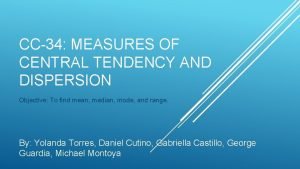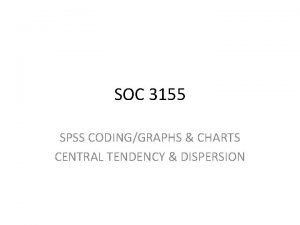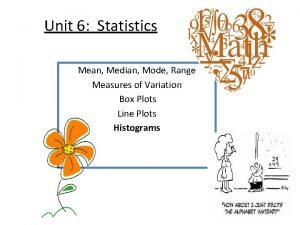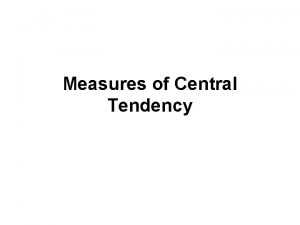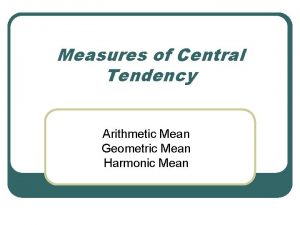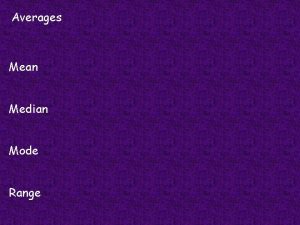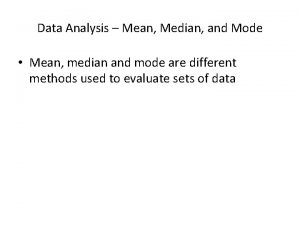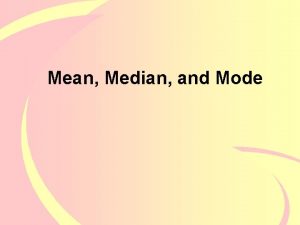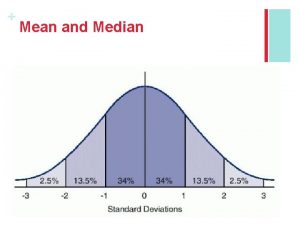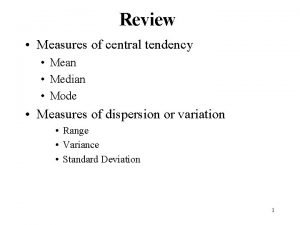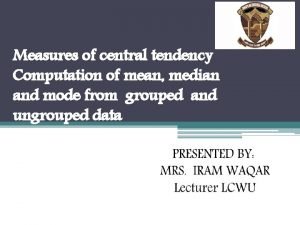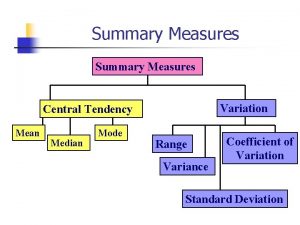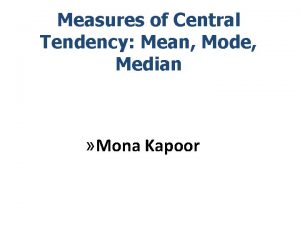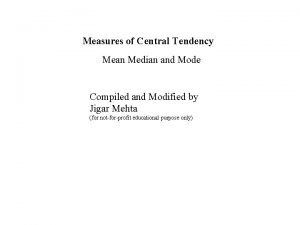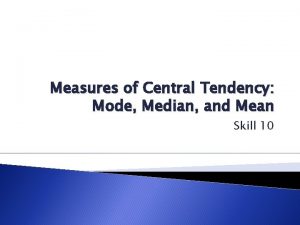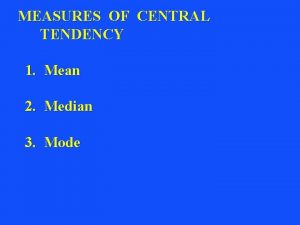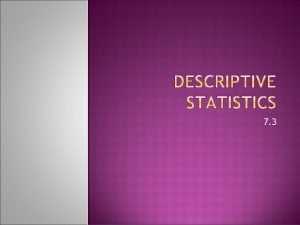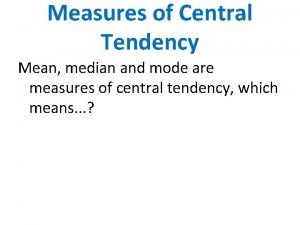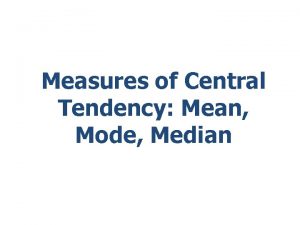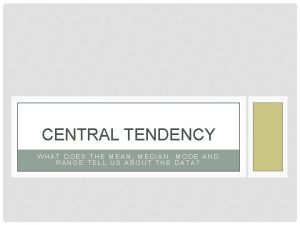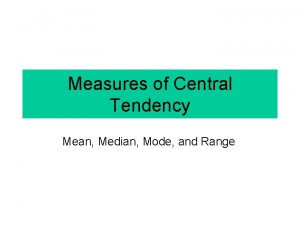LESSON 3 CENTRAL TENDENCY Outline Arithmetic mean median


































- Slides: 34

LESSON 3: CENTRAL TENDENCY Outline • Arithmetic mean, median and mode – Ungrouped data – Grouped data • Percentiles, fractiles, and quartiles – Ungrouped data – Grouped data 1

MEASURES OF CENTRAL LOCATION MEAN • Mean is defined as follows: Sum of the measurements Mean = Number of measurements • In the following, sample mean and population means are discussed separately. • Note the difference of notation - sample mean is denote by and the population mean is denoted by . The number of values in a sample is denoted by n and the number of values in the population is denoted by N. 2

MEASURES OF CENTRAL LOCATION MEAN Mean of Data Set is Sample Data Set is Population Sample Mean Population Mean 3

MEASURES OF CENTRAL LOCATION SAMPLE MEAN • The sample mean is the sum of all the sample values divided by the number of sample values: • where stands for the sample mean • n is the total number of values in the sample • is the value of the i-th observation • represents a summation 4

MEASURES OF CENTRAL LOCATION SAMPLE MEAN • Statistic: a measurable characteristic of a sample. • A sample of five executives received the following amounts of bonus last year: $12, 000, $14, 000, $18, 000, $17, 000, and $19, 000. Find the average bonus for these five executives. • Since these values represent a sample size of 5, the sample mean is (12, 000 + 14, 000 +18, 000 + 17, 000 +19, 000)/5 = 5

MEASURES OF CENTRAL LOCATION SAMPLE MEAN • Sample mean approximated from grouped data: • Where is the sample mean • is the frequency of the th class interval • is the midpoint of the th class interval • is the total number of observations, • represents a summation 6

MEASURES OF CENTRAL LOCATION SAMPLE MEAN • Compute the average days to maturity of 40 investments from the following frequency distribution: 7

MEASURES OF CENTRAL LOCATION POPULATION MEAN • The population mean is the sum of all the population values divided by the number of population values: • Where stands for the population mean • N is the total number of values in the population • is the value of the i-th observation • represents a summation 8

MEASURES OF CENTRAL LOCATION POPULATION MEAN • Parameter: a measurable characteristic of a population. • The Keller family owns four cars. The following is the mileage attained by each car: 55, 000, 25, 000, 40, 000, and 80, 000. Find the average miles covered by each car. • The mean is (55, 000 + 25, 000 + 40, 000 + 80, 000)/4 = 9

MEASURES OF CENTRAL LOCATION PROPERTIES OF MEAN 1. 2. 3. 4. 5. Data possessing an interval scale or a ratio scale, usually have a mean. All the values are included in computing the mean. A set of data has a unique mean. The mean is affected by unusually large or small data values. The arithmetic mean is the only measure of central tendency where the sum of the deviations of each value from the mean is zero. 10

MEASURES OF CENTRAL LOCATION PROPERTIES OF MEAN • Consider the set of values: 3, 8, and 4. The mean is 5. Illustrating the fifth property, (3 -5) + (8 -5) + (4 -5) = -2 +3 -1 = 0. In other words, 11

MEASURES OF CENTRAL LOCATION MEDIAN • Median: The midpoint of the values after they have been ordered from the smallest to the largest, or the largest to the smallest. • There as many values above the median as below it in the data array. • For an even set of numbers, the median will be the arithmetic average of the two middle numbers. • Median is denoted by 12

MEASURES OF CENTRAL LOCATION MEDIAN • After data are ordered – If is odd median is the – If number is even median is the arithmetic average of and number 13

MEASURES OF CENTRAL LOCATION MEDIAN • The median is the most appropriate measure of central location to use when the data under consideration are ranked data, rather than quantitative data. • For example, if 13 universities are ranked according to the reputation, university 7 is the one of median reputation. 14

MEASURES OF CENTRAL LOCATION MEDIAN • Median is used when few extreme values influence mean too much. For example, one rich family may affect the mean income. So, median income is often reported in place of mean income. • Median is used when all values are not available. For example, in life testing the experiment may end before generating all values. So, mean may not be calculated and median is used instead. 15

MEASURES OF CENTRAL LOCATION MEDIAN • Compute the median for the following data. • The age of a sample of five college students is: 21, 25, 19, 20, and 22. • Arranging the data in ascending order gives: • Thus the median is 16

MEASURES OF CENTRAL LOCATION MEDIAN • Compute the median for the following data. • The height of four basketball players, in inches, is 76, 73, 80, and 75. • Arranging the data in ascending order gives: • Thus the median is 17

MEASURES OF CENTRAL LOCATION MODE • The mode is the value of the observation that appears most frequently. • The mode is most useful when an important aspect of describing the data involves determining the number of times each value occurs. If the data are qualitative (e. g. , number of graduate in mechanical, automotive, industrial, etc. ) then, mode is useful (e. g. , a modal class is mechanical). • For grouped data, mode is the midpoint of the class interval of the highest frequency. 18

MEASURES OF CENTRAL LOCATION MODE • EXAMPLE: The exam scores for ten students are: 81, 93, 84, 75, 68, 87, 81, 75, 81, 87. • The modal score = 19

MEASURES OF CENTRAL LOCATION MODE • Find the mode for the following grouped data on days to maturity of 40 investments 20

21

MEASURES OF CENTRAL LOCATION MEAN, MEDIAN, MODE • Mean: affected by unusually large/small data, may be used if the data are quantitative (ratio or interval scale). • Median: most appropriate if the data are ranked (ordinal scale) • Mode: most appropriate if the data are qualitative (nominal scale) • Appropriate measures if the data has – ratio or interval scale: mean, median, mode – ordinal scale: median, mode – nominal scale: mode 22

FINDING MEDIAN AND MODE FROM AN ORDERED STEM-AND-LEAF PLOT Find the median and mode from the following ordered stem-and-leaf plot on days to maturity of 40 investments Stem Leaves 3 189 4 7 5 01135567 6 0234456789 7 0001589 8 0135679 9 5899 23

MEASURES OF CENTRAL LOCATION RELATIVE VALUES OF MEAN, MEDIAN, MODE Mode<Median<Mean Mode=Median=Mean<Median<Mode If distribution is if distribution is positively skewed symmetric negatively skewed 24

RELATIVE STANDING PERCENTILES, FRACTILES, QUARTILES • Percentiles divide the distribution into 100 groups. • A percentile is a point below which a stated percentage of observations lie. • The p-th percentile is a point below which p% of the values lie. • For example, if the 78 th percentile of GMAT scores is 600, then 78% scores are below 600. • Percentiles are not unique. For example, if 78% scores are below 600 and 82% scores are below 610, then the 78 th percentile may be any point above 600 and below 610. 25

RELATIVE STANDING PERCENTILES, FRACTILES, QUARTILES • Alternate to percentile is fractile. • A fractile is a point below which a stated fraction of observations lie. • The d fractile, is a point below which 100 d% of the values lie. • For example, if the 0. 78 fractile of GMAT scores is 600, then 78% scores are below 600. Alternate to the 78 th percentile is 0. 78 fractile. In this case, 26

RELATIVE STANDING PERCENTILES, FRACTILES, QUARTILES • Quartiles divide data into four groups of equal frequency. • First quartile = 25 th percentile = 0. 25 fractile = • Second quartile = 50 th percentile = 0. 50 fractile = = median • Third quartile = 75 th percentile = 0. 75 fractile = 27

RELATIVE STANDING PROCEDURE TO FIND A GIVEN PERCENTILE • Procedure to find . Assume • Step 1: Sort the data in the ascending order (low to high) • Step 2: Find which is the largest integer such that • Step 3: Compute the d fractile i. e. , 100 d-th percentile as follows • Note: Step 3 finds the required percentile by interpolating between and 28

RELATIVE STANDING PROCEDURE TO FIND A GIVEN PERCENTILE • • Example: Consider data set 2, 3, 5, 6, 8, 10, 12, 15, 18, 20. Find the 20 th percentile Note: the data set is already ordered. So, Step 1 is not necessary. Step 2: Find the largest integer So, • Step 3: Compute 29

RELATIVE STANDING PROCEDURE TO FIND A GIVEN PERCENTILE • • Example: Consider data set 2, 3, 5, 6, 8, 10, 12, 15, 18, 20. Find the 75 th percentile Note: the data set is already ordered. So, Step 1 is not necessary. Step 2: Find the largest integer So, • Step 3: Compute 30

RELATIVE STANDING PROCEDURE TO FIND A GIVEN PERCENTILE Find the 80 th percentile from the following ordered stemand-leaf plot on days to maturity of 40 investments Stem Leaves 3 189 4 7 5 01135567 6 0234456789 7 0001589 8 0135679 9 5899 31

RELATIVE STANDING: GROUPED DATA PROCEDURE TO FIND A GIVEN PERCENTILE • For the grouped data, read the percentiles directly from the graph for the cumulative relative frequency distribution. • Find the 80 th percentile from the graph for the cumulative relative frequency distribution shown on the next slide and constructed from the data on days to maturity of 40 investments. 32

OGIVE Cumulative Frequency CUMULATIVE RELATIVE FREQUENCY GRAPH 1. 000 0. 900 0. 800 0. 725 0. 600 0. 550 0. 400 0. 200 0. 000 0. 300 0. 075 0. 100 40 50 60 70 80 90 100 Number of Days to Maturity 33

READING AND EXERCISES Lesson 3 Reading: Section 2 -2, pp. 38 -47 Exercises: 2 -18, 2 -20 (and 2 -4 a), 2 -26 34
 Measures of central tendency median
Measures of central tendency median Contoh tendensi
Contoh tendensi How to find range of grouped data
How to find range of grouped data Central tendancy bias
Central tendancy bias Measures of central tendency
Measures of central tendency Central tendency and spread homework
Central tendency and spread homework Ungrouped data
Ungrouped data Objective of central tendency
Objective of central tendency Lower boundary of modal class
Lower boundary of modal class Measures of central tendency range
Measures of central tendency range Advantages of measures of central tendency
Advantages of measures of central tendency Central tendency symbols
Central tendency symbols Objectives of central tendency
Objectives of central tendency Measures of central tendency
Measures of central tendency Use of central tendency
Use of central tendency Central tendency
Central tendency Line plot mode
Line plot mode Ukuran tendensi sentral adalah
Ukuran tendensi sentral adalah Measures of central tendency symbols
Measures of central tendency symbols Pengukuran tendensi sentral
Pengukuran tendensi sentral Nxn 역행렬 알고리즘
Nxn 역행렬 알고리즘 Central tendency symbols
Central tendency symbols Variance meaning
Variance meaning Choosing the best measure of central tendency worksheets
Choosing the best measure of central tendency worksheets Why is the median useful
Why is the median useful Rumus mean
Rumus mean Central tendency symbols
Central tendency symbols Central tendency
Central tendency Measures of central tendency and variation
Measures of central tendency and variation Statistics chapter 3 measures of central tendency
Statistics chapter 3 measures of central tendency Central tendency
Central tendency Objective of central tendency
Objective of central tendency Central tendency spss
Central tendency spss Central tendency
Central tendency Mode in statistics
Mode in statistics
